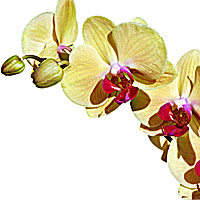
- Yang family Tai Chi.
- Tai Chi Steps, Tai Chi Posture Guidelines.
- Online tutorials covering one of the most popular sets of Tai Chi techniques.
- All little details covered. Beginners and advanced readers will find it equally useful.
Techniques of the Taiji Qigong (Taichi Qigong) are somewhere between the "dynamic" Tai Chi Meditation, and static Qigong Meditation. When we do these exercises, we move, and if you are familiar with the Tai Chi, you might recognize some of the motions.
In the same time, Taichi Qigong Exercises and Meditation techniques are very compact, in terms of space it requires. You will only need to do one step forward and one to the side.
Same way as in Tai Chi Meditation, Taichi Qigong Meditation is simple to do, and the "energy" flow is usually easier to achieve, then when you practice Qigong. It can be performed as a standalone set of exercises, however the effect will be much more noticeable, if you follow the "recommended" routine: warm-up, Qigong, Taichi Qigong, and then Tai Chi.
There are many sets (sometimes called tao) in Taiji Qigong. They are used to improve different aspects of our health. In this eBook you will learn one of them, probably the most important: the Taiji Qigong 18 form. When done properly, it is affecting all our body, improving health. Also it will help you to open your energy channels and to learn to relax, physically and mentally.
If you do it right, Taiji Qigong is safe. If you make errors, or if you have some (very rare) health conditions, it may create unpleasant sensations. I am not going to discuss these "dangers" here, as there are sources in the Internet, dealing with the issue. I believe, that if you do it in a relaxed way, without pushing and if you do not do techniques that feel unpleasant - you will be fine. Nevertheless, read the disclaimer and find a local guru, if in doubts.
Qi Gong Exercise: Sample
This is a sample chapter from the eBook (see below).
Catching the fish.
We have finished the previous exercise in the ma bu position, with our hands to the left. Now leave your left hand where it is, and move your right hand only, doing the same move you did in the previous exercise. In the same time turn your shoulders, so that you are facing forward (your torso was turned 45 degrees to the left before).

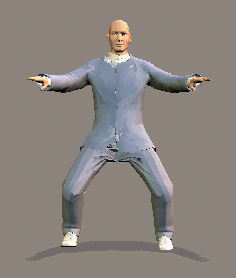
Now move your weight to the right foot and bring your left foot to the middle of the right foot. Hands should be still to the sides (remember, we never have hands in the plane where the back is. "To the sides" means 30 degrees forward from that plane).
This position is called din bu. Let's outline the most important points here, for a complete guide, see the Tai Chi 24 Form tutorial.
First of all, we just did a step. There are some very strict rules about steps in Tai Chi Meditation. First of all, only an "empty" foot can move. It means that in order to lift the foot from the ground, you need to have no weight on this foot. You can not push from the ground, you can not move some weight and then drag the foot from one position to another.
Second, your front foot should touch the ground, but there should still be no weight on it. The heel should be up, and the contact with the floor should be on the base of the toes.
The right leg should be bent. Also note, that the right foot is now turned 45 degrees to the right. There is no strict rules about the moment you do it, but the best time is probably before you move your weight. Also, the "feet should be parallel in ma bu" rule is not very strict in this set of exercises, so some people do it with toes pointing to the sides. It is easier to sit down in ma bu, and, especially for beginners, it is not a mistake. Still, I don't like it.

What we are about to do is called an empty step. Put your left foot on the heel, forward and slightly to the left. Keep the weight on the right foot - that is why the step is called "empty".
Note (it is one of the most common mistakes), that we cannot put our EMPTY heel forward, if our right foot is not bent. It is impossible - our legs have equal length. If one is perpendicular to the ground (as we stay on it, it is), the other can either be perpendicular too, or it should be longer than the first one, or it will not touch the floor. UNLESS we bend the right leg.
In Tai Chi, we walk in a smooth way, so that our center of gravity does not jump up and down. Once our leg is bent, we need to move in such way, that our head remains on the same level. When we do an empty step, we don't bend the right knee more than it is bent already.
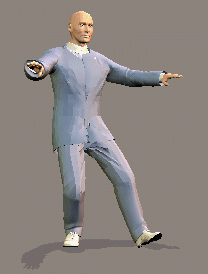
Now move about 70% of your weight to the left foot. This position is called gun bu, as you already know, Gun means work. A working position. The left knee should be above the toes. It is different in different martial arts, so don't worry. For example, in Kyokushinkai karate you would be told that the knee should be above the heel (shin vertical). In Tai Chi Meditation it is a little different.
The central line of your body, if you continue it down, should cross the floor between your feet, in the middle, not closer to your left foot.
The right knee should be almost straight, but still (as usual) slightly bent. When you moved all 70% of your weight, turn the right heel. If at the beginning it was 45 degrees to the right, now it should be almost parallel to the left foot (which is pointing forward), but still slightly turned to the right.
The back should be straight and vertical. Also learn not to look down at your feet - they are there and you don't have to look to make sure.
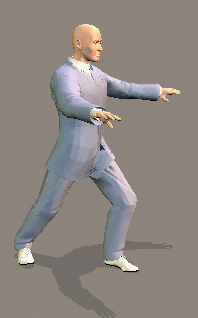
You now are in the initial position for the exercise.
Bend forward, but keep your back straight. Also, bend to the central line, and not to the front foot. In the same time move your hands forward at the level of shoulders (as you are bending, hands will go down). The motion of the hands and the bending should be synchronized, so that the left palm is on top of the right wrist (there should be about 2 inches between them) the moment you done bending. The mental image is of catching a fish with your hands (it is just a metaphor, you don't have to keep the image in your mind all the time).
Look at 45 degrees forward (to the point on the floor ahead of you).
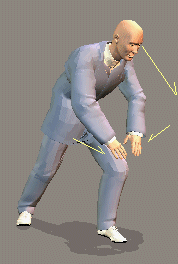
Continue moving hands in the same direction, completing the circles. At some point they will cross and then go to the sides (right hand to the right, left hand to the left). The final distance between the palms is about the width of your shoulders. You are demonstrating, how big the fish is, but don't exaggerate too much.
In the same time, move your weight from your front foot to your back foot, so that the front foot is almost empty. The left (front) foot should still remain on the ground.
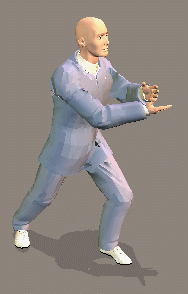
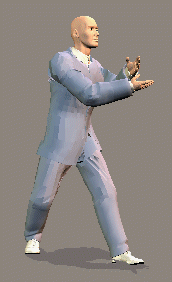
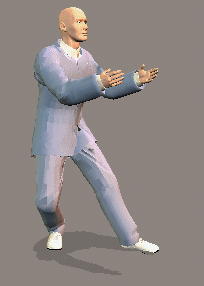
As you probably already noticed, the trajectory of a hand in this exercise is outside - up, outside - down, inside - up, outside - up. Continue the movement by bringing hands down again - we are repeating the first part of an exercise, except this time hands are not as wide as during the first "cycle".
This exercise, as well as all exercises of this set, involving gun bu position are done six times. There is no right hand gun bu in this set of exercises.
The breathing should be thin, relaxed. Exhale when bending, inhale when going up.
